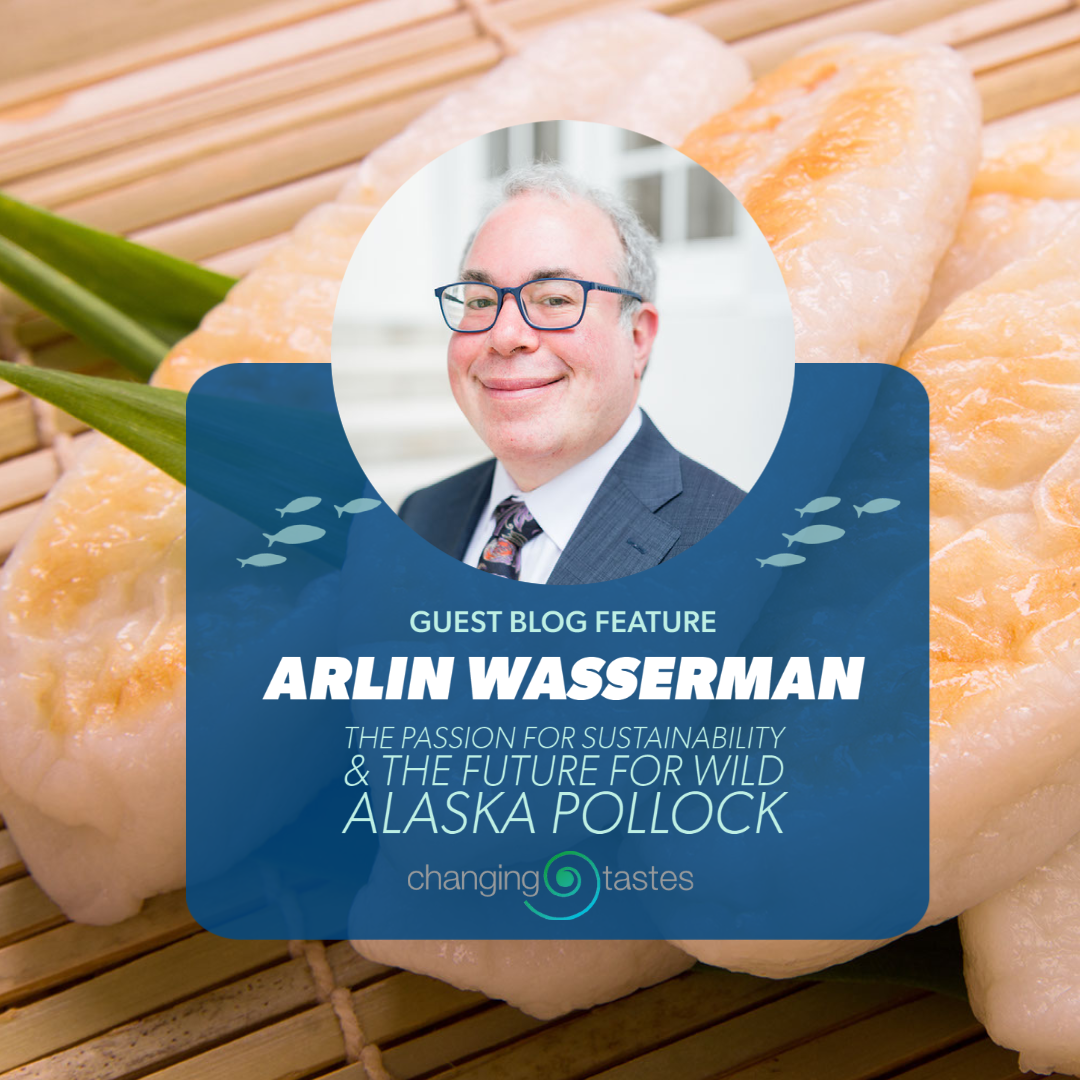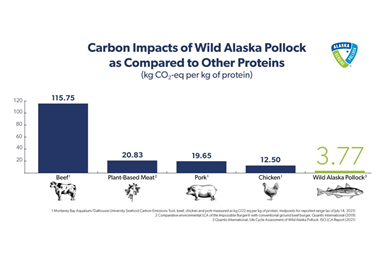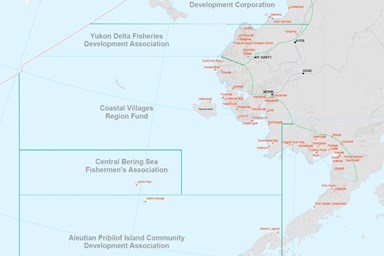Arlin Wasserman , November 11, 2021
The Passion for Sustainability & the Future for Wild Alaska Pollock

At the October 27th Association of Genuine Alaska Pollock Producers (GAPP) Annual Meeting, Arlin Wasserman, founder of Changing Tastes, spoke about the future for Wild Alaska Pollock and how bright it is. We wanted to hear more from him about this burgeoning future for the best whitefish in the world! Read on below to see what he had to say about all things sustainability, his passion for new foods and evolving consumers, and the next steps for Wild Alaska Pollock.
Tell us about Changing Tastes, how it started and what drives your business.
I and my firm have been working for the past two decades to try and make our food more sustainable, healthier, more delicious, and more profitable for the companies involved in producing and selling it.
Americans under-index on seafood consumption. How can we change that trend and introduce them to Wild Alaska Pollock?
When we think about increasing the consumption of food from the ocean which often has a smaller footprint than food from the land, especially Wild Alaska Pollock, we know that this is an important change to make and one that we feel optimistic that can be made.
About a decade ago I decided to focus on protein because it’s the part of our diet that has the biggest environmental footprint. If in your daily life you encounter things like chicken produced without antibiotics and the blended burger, these are all changes my firm initiated. We know that these changes in protein matter and we also know that they are possible.
The opportunity for Wild Alaska Pollock is great because it’s so flexible and can be cooked and served in so many ways. It’s just not commonly used or served in as many ways as it should be. It also has a great frozen shelf life, so to the extent that supply is dependable, you have a leg up on the global seafood supply chain.
It’s only in recent years that we’ve really started thinking about making the right proteins. This is another area—beyond convenience, versatility, and affordability, that Wild Alaska Pollock can win because Americans have been taught for decades to be scared of fats and taught to fear the carb monster. So here we have a low carb, low fat, high protein food to offer.
Sustainability is growing in importance to consumers every day and has certainly been top of mind with the recent climate summit in Glasgow with so many of our world’s leaders in attendance. Let’s talk about that.
Since 2005 Americans have replaced over 10lbs of red meat in their diets with other stuff, mostly larger amounts of chicken, as well as about 2lbs of fish and seafood. That change in the proteins we eat has reduced the entire carbon footprint of our country and gotten us to about 15% of our nation’s total carbon reduction goal that President Biden just announced.
Looking ahead, we have more work to do to achieve President Biden's ambitious and necessary goals for climate change and I think that Wild Alaska Pollock can be a meaningful part of achieving those goals. Changing Tastes has done consumer research to figure out how we can continue to improve our protein choices and help get the rest of the way there.
We found out that over a third of American’s want to eat less meat, which has been the case for at least several years. The big change over the past year or two is that their number one choice for replacing red meat is fish and seafood, and their interest in plant-based replacements is declining.
When we model what those dietary changes will mean for reducing our carbon footprint, the results could be mixed. If we fly in farmed salmon and intensively farmed shrimp, we’ll get some modest improvements. But if we replace meat with fish like Wild Alaska Pollok, we’ll gain another 5-10% of our climate goals—which could be significant. Simply changing what we eat could help our country achieve a quarter of its climate reduction goals, leaving the rest to energy, transportation, and other sectors.
You’ve been passionate about sustainability for some time. Tell us why.
Sustainability and business have always been a passion of mine, along with food. Nearly 40 years ago, I was the first student at the University of Michigan to be enrolled in the school of natural resources and in the business school. Now there are formal degree programs in sustainable business. While I was in college, I, along with a couple of great colleagues, launched the first weekly recycling pickup program—that didn’t exist in the U.S. before.
You could say I’ve been doing sustainability a long time. After Sodexo headhunted me to be their first head of sustainability, one of my first moves was to work with great students at Duke University and the University of Michigan to conduct an extensive footprint analysis of more than a thousand of the food items most used in foodservice. It was one of the first large-scale carbon footprint analyses ever done. We also looked at the footprint of our corporate activities and quickly started focusing on menus.
We found out that making changes in what we served, especially proteins, would have the biggest impact. That led me to create the plant-forward strategy of slightly reducing the amount of meat in recipes and on menus. Later, the Culinary Institute of America and Harvard University hired Changing Tastes to create the Menus of Change program which I chaired for about seven years and continues to carry some of those ideas forward.
It's always been a passion and we’re just getting started. It’s all about seeing the solution you want to achieve and making it happen, not getting caught up studying problems in more detail than you need.
Wild Alaska Pollock has had challenges moving outside of the quick-service-restaurant category to higher-end establishments. What experiences have you had that could be illustrative for the industry in surmounting this challenge?
When I was leading Menus of Change back in 2012, I had my then colleague Jeremey Bearman, a brilliant chef, demonstrate the blended burger, replacing 25% of ground beef with plant-based ingredients like diced mushrooms, on stage while the program also addressed climate change. Chef Jeremy gave a clear model for how to make this change that other chefs could easily adopt. It remains at the core of plant-forward culinary strategies and we’re very happy how things have taken off since then. When we did that, the blended burger started in fine dining and also in high volume foodservice, and then trickled down into QSR. The innovation of the blended burger alone and mushroom consumption has increased by about half a pound per person. We also worked with the Mushroom Council to start developing a sustainability platform for the industry that mirrored the climate benefits and others associated with change on the menus.
With Wild Alaska Pollock and especially things like surimi and mince, the challenges are somewhat the same but not entirely. Particularly for surimi, we need to change chef perception of the products to think of these as minimally processed foods with its own unique quality, not a highly processed food meant to replace better “real” seafood like crab. Clean ingredient labels are a quick way to get there.
We also know that we need new ways to cook softer fish like pollock that can be successfully cooked by today’s restaurant workforce, which is often understaffed, and fit into the menu formats and cycles that restaurants are rebuilding after COVID. We’ve done this before and developed ways to utilize sole from the Pacific Coast once the ground fishery reopened. Sole shares some of these same cooking challenges, and we turned it into the most popular menu item for our clients during a commercial trial just before COVID. We know how to do know is this and there’s a desire by chefs to put more seafood on the menu.
We think that treating Wild Alaska Pollock products, like surimi, as one of America’s lowest carbon proteins will help get us there. Look for what is better for the environment, flexible to use as the center of the plate message has done for cauliflower, once relegated to be an occasional side dish, for example.
We also need to increase the frequency that Wild Alaska Pollock is eaten, which also means new ways to use it. We’ve always put our proteins as Americans at the center of the plate, but there are other ways we can use Wild Alaska Pollock. So, we’re excited about using it in spreads and sauces that offer consumers seafood and clean protein in unexpected yet familiar and delicious ways.
Why should our members hire Changing Tastes?
We have a tremendous track record of catalyzing delicious, sustainable, and profitable changes in what we eat and using a mix of industry experience, sustainability, and culinary strategy to shift the mix of what grocery retail and restaurant hospitality offer us. We’ve accomplished great things with some of the producer groups we’ve worked with and our attention is now focused on increasing the share of food that Americans get from the ocean. We know there are ways to do this that are most beneficial, including foods with a very low carbon footprint like Alaskan pollock.
There’s no reason to wait to get started.
We have some specific thoughts about surimi and other Wild Alaska Pollock products. Surimi and other products have a lot of attributes that can help move your products to new eating occasions and other places on the menu and in the grocery store. We think that the research we’ve done about interest in switching proteins is important and can help reposition pollock to be offered and eaten more often in more ways.
The other thing to look at is the act of grocery shopping and how that has changed due to COVID. Before when Americans shopped, they would eat seafood no more than once every time they went to the grocery store. During COVID, we reduced our frequency of grocery store visits—for 95% of Americans, they have kept up the pattern of only eating seafood at one meal per grocery store visit. Cracking the code to have consumers eat fish or seafood at home several times per grocery visit can drive up consumption. Surimi has great life once it’s thawed, and we can get several meals from it. You may also want to snack on it and use it for other occasions.
Those are a few of the things the industry should be looking at and we’d be glad to help “thread the needle” of having pollock offered more often in more ways so it can be eaten more often.

